Academic Misconduct: Impact and Strategies
VerifiedAdded on 2023/01/11
|12
|5552
|95
AI Summary
This article discusses the impact of academic misconduct and strategies to prevent it. It covers the consequences and regulations related to academic misconduct. The focus is on understanding the importance of ethical practices in academic settings.
Contribute Materials
Your contribution can guide someone’s learning journey. Share your
documents today.
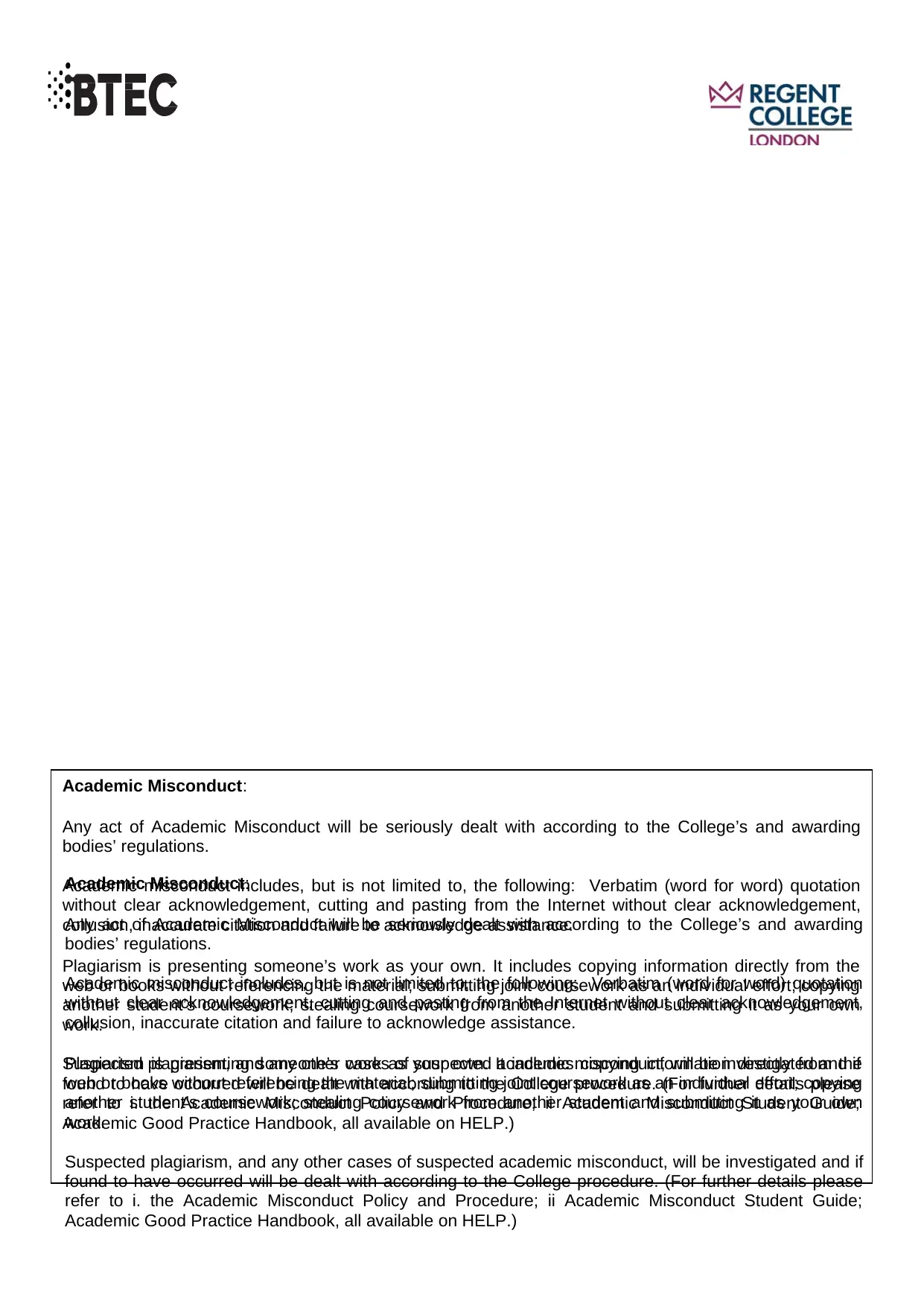
Academic Misconduct:
Any act of Academic Misconduct will be seriously dealt with according to the College’s and awarding
bodies’ regulations.
Academic misconduct includes, but is not limited to, the following: Verbatim (word for word) quotation
without clear acknowledgement, cutting and pasting from the Internet without clear acknowledgement,
collusion, inaccurate citation and failure to acknowledge assistance.
Plagiarism is presenting someone’s work as your own. It includes copying information directly from the
web or books without referencing the material; submitting joint coursework as an individual effort; copying
another student’s coursework; stealing coursework from another student and submitting it as your own
work.
Suspected plagiarism, and any other cases of suspected academic misconduct, will be investigated and if
found to have occurred will be dealt with according to the College procedure. (For further details please
refer to i. the Academic Misconduct Policy and Procedure; ii Academic Misconduct Student Guide;
Academic Good Practice Handbook, all available on HELP.)
Academic Misconduct:
Any act of Academic Misconduct will be seriously dealt with according to the College’s and awarding
bodies’ regulations.
Academic misconduct includes, but is not limited to, the following: Verbatim (word for word) quotation
without clear acknowledgement, cutting and pasting from the Internet without clear acknowledgement,
collusion, inaccurate citation and failure to acknowledge assistance.
Plagiarism is presenting someone’s work as your own. It includes copying information directly from the
web or books without referencing the material; submitting joint coursework as an individual effort; copying
another student’s coursework; stealing coursework from another student and submitting it as your own
work.
Suspected plagiarism, and any other cases of suspected academic misconduct, will be investigated and if
found to have occurred will be dealt with according to the College procedure. (For further details please
refer to i. the Academic Misconduct Policy and Procedure; ii Academic Misconduct Student Guide;
Academic Good Practice Handbook, all available on HELP.)
Any act of Academic Misconduct will be seriously dealt with according to the College’s and awarding
bodies’ regulations.
Academic misconduct includes, but is not limited to, the following: Verbatim (word for word) quotation
without clear acknowledgement, cutting and pasting from the Internet without clear acknowledgement,
collusion, inaccurate citation and failure to acknowledge assistance.
Plagiarism is presenting someone’s work as your own. It includes copying information directly from the
web or books without referencing the material; submitting joint coursework as an individual effort; copying
another student’s coursework; stealing coursework from another student and submitting it as your own
work.
Suspected plagiarism, and any other cases of suspected academic misconduct, will be investigated and if
found to have occurred will be dealt with according to the College procedure. (For further details please
refer to i. the Academic Misconduct Policy and Procedure; ii Academic Misconduct Student Guide;
Academic Good Practice Handbook, all available on HELP.)
Academic Misconduct:
Any act of Academic Misconduct will be seriously dealt with according to the College’s and awarding
bodies’ regulations.
Academic misconduct includes, but is not limited to, the following: Verbatim (word for word) quotation
without clear acknowledgement, cutting and pasting from the Internet without clear acknowledgement,
collusion, inaccurate citation and failure to acknowledge assistance.
Plagiarism is presenting someone’s work as your own. It includes copying information directly from the
web or books without referencing the material; submitting joint coursework as an individual effort; copying
another student’s coursework; stealing coursework from another student and submitting it as your own
work.
Suspected plagiarism, and any other cases of suspected academic misconduct, will be investigated and if
found to have occurred will be dealt with according to the College procedure. (For further details please
refer to i. the Academic Misconduct Policy and Procedure; ii Academic Misconduct Student Guide;
Academic Good Practice Handbook, all available on HELP.)
Secure Best Marks with AI Grader
Need help grading? Try our AI Grader for instant feedback on your assignments.
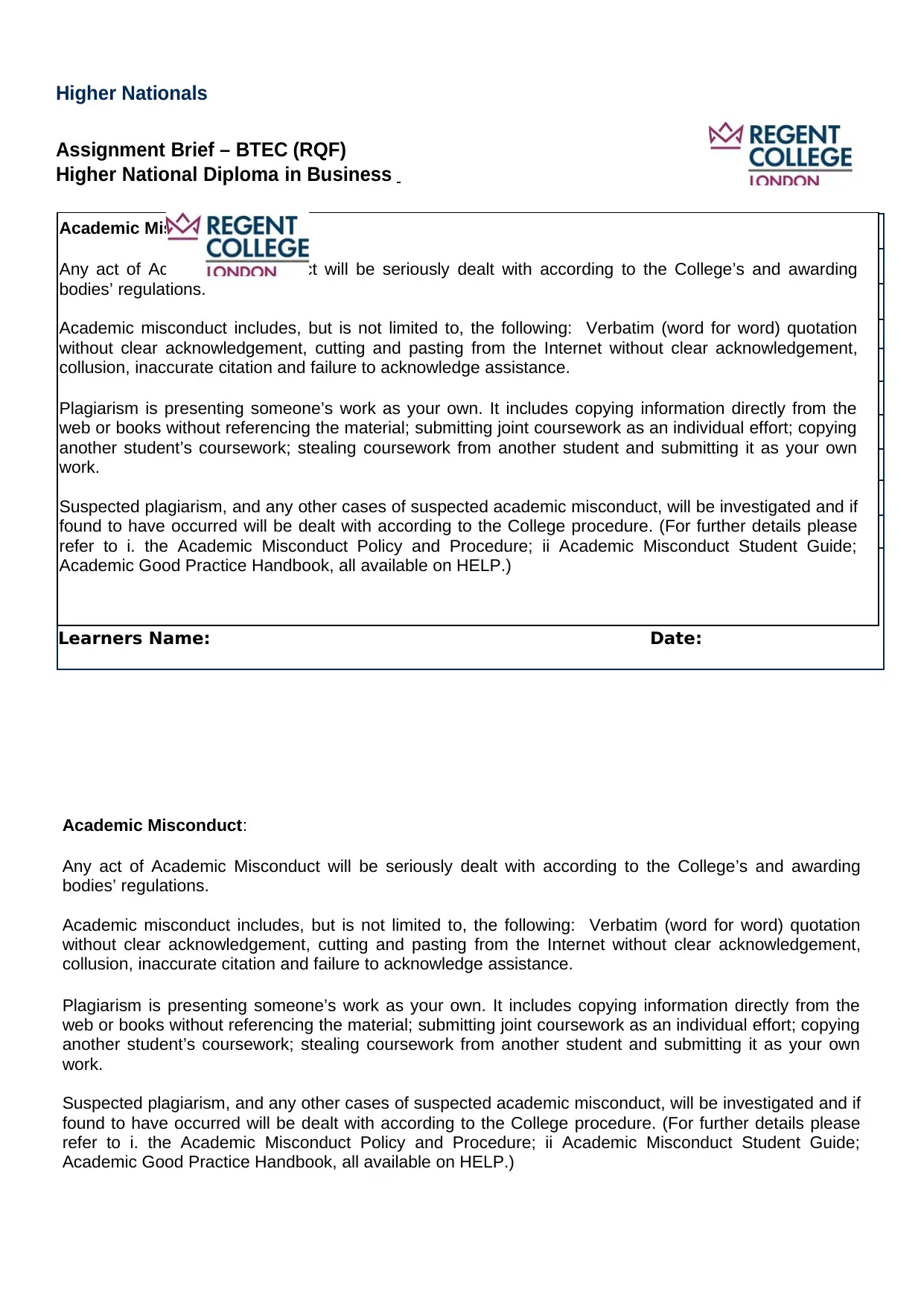
Higher Nationals
Assignment Brief – BTEC (RQF)
Higher National Diploma in Business
Gabriel Zoita ID HE07501
Unit Number and Title Unit 32- Business Strategy
Academic Year 2019/2020 Cohort April19 Term 1
Unit Leader Syed Ahmed Assess
or
Rahima Khatoon
Assignment Title Nissan Strategy Report
Issue Date 04/05/2020
Submission Start Date
(Formative) 15/06/2020
Submission Summative 26/06/2020
IV Name Seethalakshmy Nagarajan
IV Date 05.05.2020
Learners Declaration: I certify that the work submitted for this unit is my own and
the research sources are fully acknowledged.
Learners Name: Date:
Academic Misconduct:
Any act of Academic Misconduct will be seriously dealt with according to the College’s and awarding
bodies’ regulations.
Academic misconduct includes, but is not limited to, the following: Verbatim (word for word) quotation
without clear acknowledgement, cutting and pasting from the Internet without clear acknowledgement,
collusion, inaccurate citation and failure to acknowledge assistance.
Plagiarism is presenting someone’s work as your own. It includes copying information directly from the
web or books without referencing the material; submitting joint coursework as an individual effort; copying
another student’s coursework; stealing coursework from another student and submitting it as your own
work.
Suspected plagiarism, and any other cases of suspected academic misconduct, will be investigated and if
found to have occurred will be dealt with according to the College procedure. (For further details please
refer to i. the Academic Misconduct Policy and Procedure; ii Academic Misconduct Student Guide;
Academic Good Practice Handbook, all available on HELP.)
Academic Misconduct:
Any act of Academic Misconduct will be seriously dealt with according to the College’s and awarding
bodies’ regulations.
Academic misconduct includes, but is not limited to, the following: Verbatim (word for word) quotation
without clear acknowledgement, cutting and pasting from the Internet without clear acknowledgement,
collusion, inaccurate citation and failure to acknowledge assistance.
Plagiarism is presenting someone’s work as your own. It includes copying information directly from the
web or books without referencing the material; submitting joint coursework as an individual effort; copying
another student’s coursework; stealing coursework from another student and submitting it as your own
work.
Suspected plagiarism, and any other cases of suspected academic misconduct, will be investigated and if
found to have occurred will be dealt with according to the College procedure. (For further details please
refer to i. the Academic Misconduct Policy and Procedure; ii Academic Misconduct Student Guide;
Academic Good Practice Handbook, all available on HELP.)
Assignment Brief – BTEC (RQF)
Higher National Diploma in Business
Gabriel Zoita ID HE07501
Unit Number and Title Unit 32- Business Strategy
Academic Year 2019/2020 Cohort April19 Term 1
Unit Leader Syed Ahmed Assess
or
Rahima Khatoon
Assignment Title Nissan Strategy Report
Issue Date 04/05/2020
Submission Start Date
(Formative) 15/06/2020
Submission Summative 26/06/2020
IV Name Seethalakshmy Nagarajan
IV Date 05.05.2020
Learners Declaration: I certify that the work submitted for this unit is my own and
the research sources are fully acknowledged.
Learners Name: Date:
Academic Misconduct:
Any act of Academic Misconduct will be seriously dealt with according to the College’s and awarding
bodies’ regulations.
Academic misconduct includes, but is not limited to, the following: Verbatim (word for word) quotation
without clear acknowledgement, cutting and pasting from the Internet without clear acknowledgement,
collusion, inaccurate citation and failure to acknowledge assistance.
Plagiarism is presenting someone’s work as your own. It includes copying information directly from the
web or books without referencing the material; submitting joint coursework as an individual effort; copying
another student’s coursework; stealing coursework from another student and submitting it as your own
work.
Suspected plagiarism, and any other cases of suspected academic misconduct, will be investigated and if
found to have occurred will be dealt with according to the College procedure. (For further details please
refer to i. the Academic Misconduct Policy and Procedure; ii Academic Misconduct Student Guide;
Academic Good Practice Handbook, all available on HELP.)
Academic Misconduct:
Any act of Academic Misconduct will be seriously dealt with according to the College’s and awarding
bodies’ regulations.
Academic misconduct includes, but is not limited to, the following: Verbatim (word for word) quotation
without clear acknowledgement, cutting and pasting from the Internet without clear acknowledgement,
collusion, inaccurate citation and failure to acknowledge assistance.
Plagiarism is presenting someone’s work as your own. It includes copying information directly from the
web or books without referencing the material; submitting joint coursework as an individual effort; copying
another student’s coursework; stealing coursework from another student and submitting it as your own
work.
Suspected plagiarism, and any other cases of suspected academic misconduct, will be investigated and if
found to have occurred will be dealt with according to the College procedure. (For further details please
refer to i. the Academic Misconduct Policy and Procedure; ii Academic Misconduct Student Guide;
Academic Good Practice Handbook, all available on HELP.)

BUSINESS STRATEGY
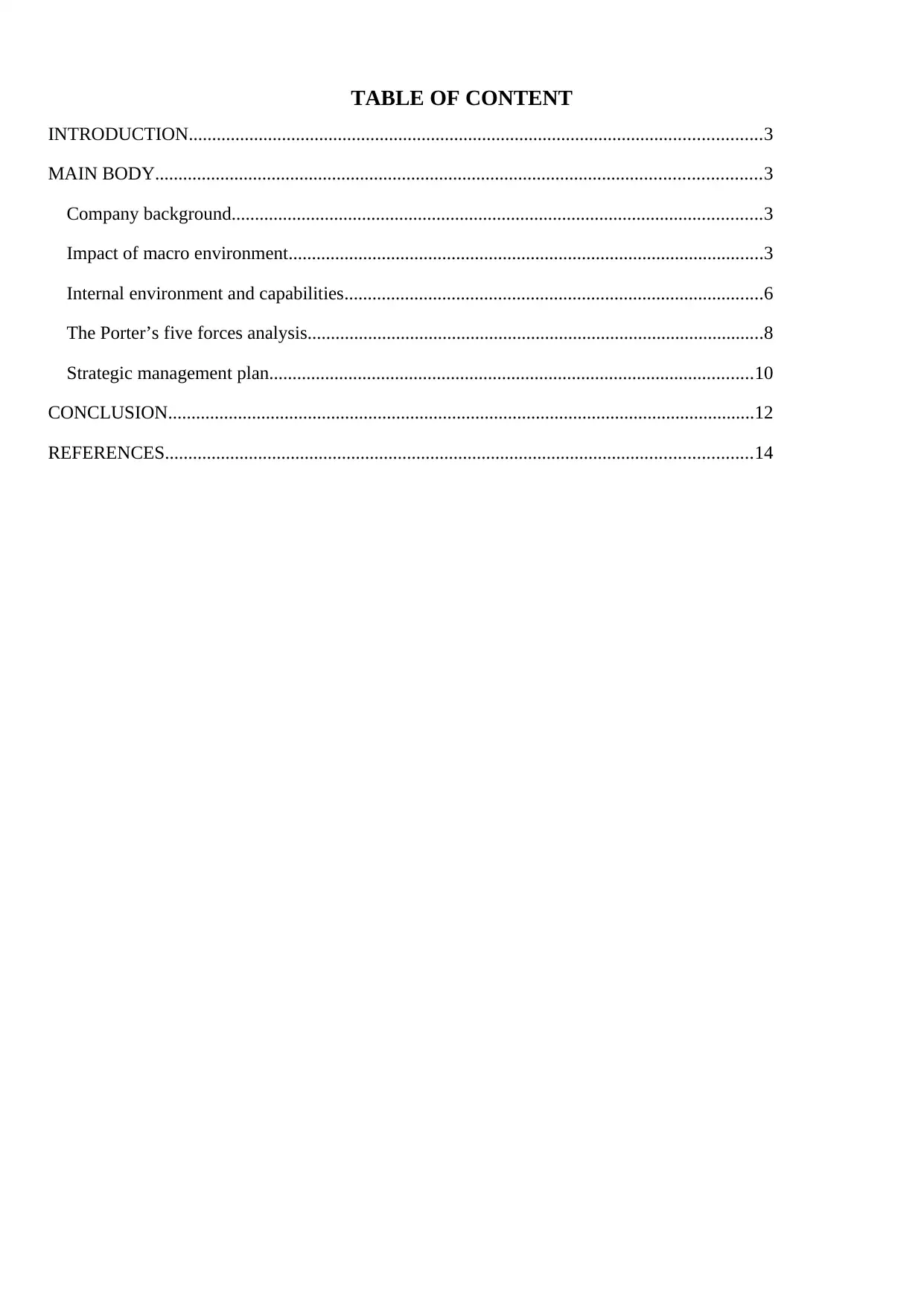
TABLE OF CONTENT
INTRODUCTION...........................................................................................................................3
MAIN BODY..................................................................................................................................3
Company background..................................................................................................................3
Impact of macro environment......................................................................................................3
Internal environment and capabilities..........................................................................................6
The Porter’s five forces analysis..................................................................................................8
Strategic management plan........................................................................................................10
CONCLUSION..............................................................................................................................12
REFERENCES..............................................................................................................................14
INTRODUCTION...........................................................................................................................3
MAIN BODY..................................................................................................................................3
Company background..................................................................................................................3
Impact of macro environment......................................................................................................3
Internal environment and capabilities..........................................................................................6
The Porter’s five forces analysis..................................................................................................8
Strategic management plan........................................................................................................10
CONCLUSION..............................................................................................................................12
REFERENCES..............................................................................................................................14
Secure Best Marks with AI Grader
Need help grading? Try our AI Grader for instant feedback on your assignments.
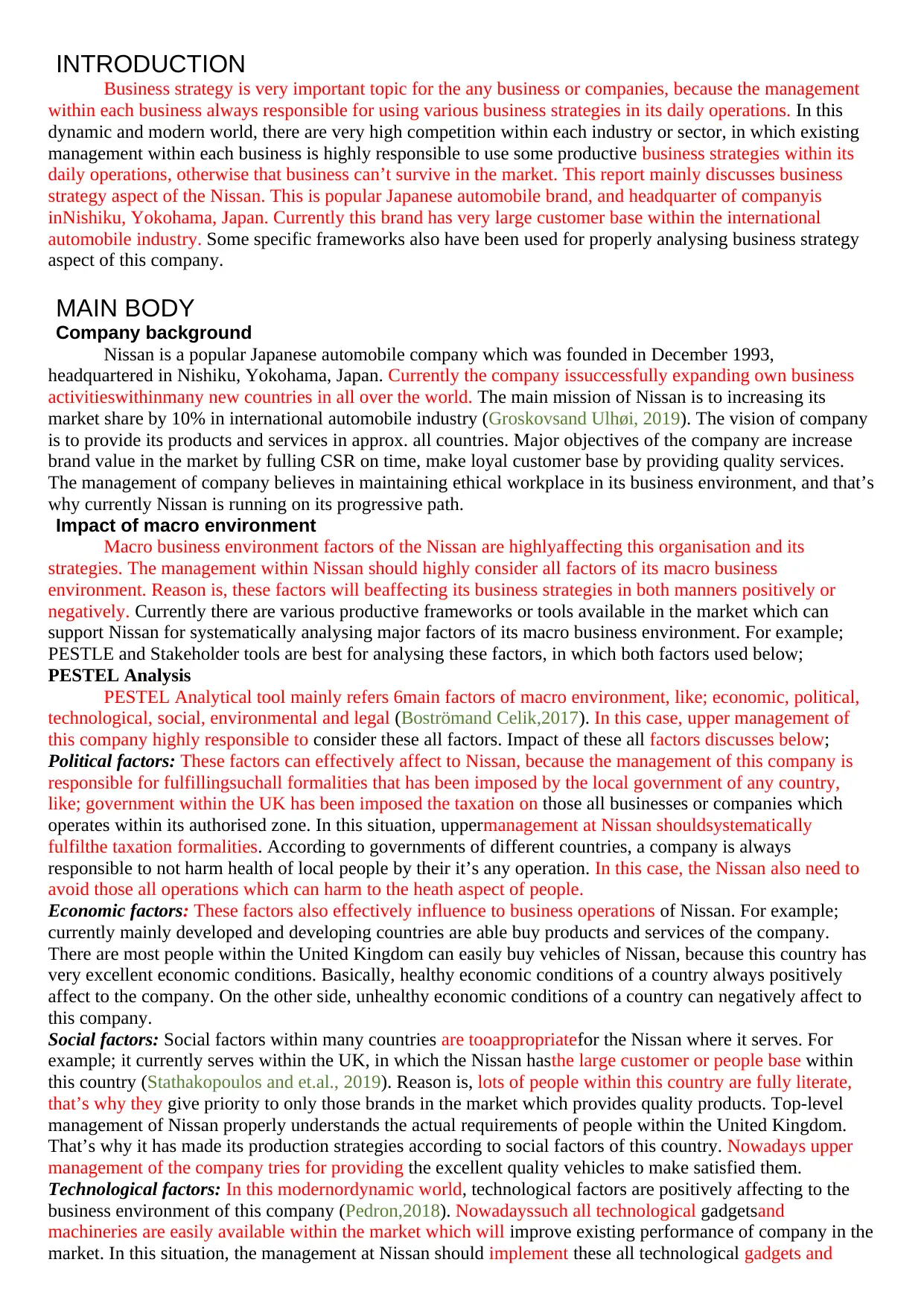
INTRODUCTION
Business strategy is very important topic for the any business or companies, because the management
within each business always responsible for using various business strategies in its daily operations. In this
dynamic and modern world, there are very high competition within each industry or sector, in which existing
management within each business is highly responsible to use some productive business strategies within its
daily operations, otherwise that business can’t survive in the market. This report mainly discusses business
strategy aspect of the Nissan. This is popular Japanese automobile brand, and headquarter of companyis
inNishiku, Yokohama, Japan. Currently this brand has very large customer base within the international
automobile industry. Some specific frameworks also have been used for properly analysing business strategy
aspect of this company.
MAIN BODY
Company background
Nissan is a popular Japanese automobile company which was founded in December 1993,
headquartered in Nishiku, Yokohama, Japan. Currently the company issuccessfully expanding own business
activitieswithinmany new countries in all over the world. The main mission of Nissan is to increasing its
market share by 10% in international automobile industry (Groskovsand Ulhøi, 2019). The vision of company
is to provide its products and services in approx. all countries. Major objectives of the company are increase
brand value in the market by fulling CSR on time, make loyal customer base by providing quality services.
The management of company believes in maintaining ethical workplace in its business environment, and that’s
why currently Nissan is running on its progressive path.
Impact of macro environment
Macro business environment factors of the Nissan are highlyaffecting this organisation and its
strategies. The management within Nissan should highly consider all factors of its macro business
environment. Reason is, these factors will beaffecting its business strategies in both manners positively or
negatively. Currently there are various productive frameworks or tools available in the market which can
support Nissan for systematically analysing major factors of its macro business environment. For example;
PESTLE and Stakeholder tools are best for analysing these factors, in which both factors used below;
PESTEL Analysis
PESTEL Analytical tool mainly refers 6main factors of macro environment, like; economic, political,
technological, social, environmental and legal (Boströmand Celik,2017). In this case, upper management of
this company highly responsible to consider these all factors. Impact of these all factors discusses below;
Political factors: These factors can effectively affect to Nissan, because the management of this company is
responsible for fulfillingsuchall formalities that has been imposed by the local government of any country,
like; government within the UK has been imposed the taxation on those all businesses or companies which
operates within its authorised zone. In this situation, uppermanagement at Nissan shouldsystematically
fulfilthe taxation formalities. According to governments of different countries, a company is always
responsible to not harm health of local people by their it’s any operation. In this case, the Nissan also need to
avoid those all operations which can harm to the heath aspect of people.
Economic factors: These factors also effectively influence to business operations of Nissan. For example;
currently mainly developed and developing countries are able buy products and services of the company.
There are most people within the United Kingdom can easily buy vehicles of Nissan, because this country has
very excellent economic conditions. Basically, healthy economic conditions of a country always positively
affect to the company. On the other side, unhealthy economic conditions of a country can negatively affect to
this company.
Social factors: Social factors within many countries are tooappropriatefor the Nissan where it serves. For
example; it currently serves within the UK, in which the Nissan hasthe large customer or people base within
this country (Stathakopoulos and et.al., 2019). Reason is, lots of people within this country are fully literate,
that’s why they give priority to only those brands in the market which provides quality products. Top-level
management of Nissan properly understands the actual requirements of people within the United Kingdom.
That’s why it has made its production strategies according to social factors of this country. Nowadays upper
management of the company tries for providing the excellent quality vehicles to make satisfied them.
Technological factors: In this modernordynamic world, technological factors are positively affecting to the
business environment of this company (Pedron,2018). Nowadayssuch all technological gadgetsand
machineries are easily available within the market which will improve existing performance of company in the
market. In this situation, the management at Nissan should implement these all technological gadgets and
Business strategy is very important topic for the any business or companies, because the management
within each business always responsible for using various business strategies in its daily operations. In this
dynamic and modern world, there are very high competition within each industry or sector, in which existing
management within each business is highly responsible to use some productive business strategies within its
daily operations, otherwise that business can’t survive in the market. This report mainly discusses business
strategy aspect of the Nissan. This is popular Japanese automobile brand, and headquarter of companyis
inNishiku, Yokohama, Japan. Currently this brand has very large customer base within the international
automobile industry. Some specific frameworks also have been used for properly analysing business strategy
aspect of this company.
MAIN BODY
Company background
Nissan is a popular Japanese automobile company which was founded in December 1993,
headquartered in Nishiku, Yokohama, Japan. Currently the company issuccessfully expanding own business
activitieswithinmany new countries in all over the world. The main mission of Nissan is to increasing its
market share by 10% in international automobile industry (Groskovsand Ulhøi, 2019). The vision of company
is to provide its products and services in approx. all countries. Major objectives of the company are increase
brand value in the market by fulling CSR on time, make loyal customer base by providing quality services.
The management of company believes in maintaining ethical workplace in its business environment, and that’s
why currently Nissan is running on its progressive path.
Impact of macro environment
Macro business environment factors of the Nissan are highlyaffecting this organisation and its
strategies. The management within Nissan should highly consider all factors of its macro business
environment. Reason is, these factors will beaffecting its business strategies in both manners positively or
negatively. Currently there are various productive frameworks or tools available in the market which can
support Nissan for systematically analysing major factors of its macro business environment. For example;
PESTLE and Stakeholder tools are best for analysing these factors, in which both factors used below;
PESTEL Analysis
PESTEL Analytical tool mainly refers 6main factors of macro environment, like; economic, political,
technological, social, environmental and legal (Boströmand Celik,2017). In this case, upper management of
this company highly responsible to consider these all factors. Impact of these all factors discusses below;
Political factors: These factors can effectively affect to Nissan, because the management of this company is
responsible for fulfillingsuchall formalities that has been imposed by the local government of any country,
like; government within the UK has been imposed the taxation on those all businesses or companies which
operates within its authorised zone. In this situation, uppermanagement at Nissan shouldsystematically
fulfilthe taxation formalities. According to governments of different countries, a company is always
responsible to not harm health of local people by their it’s any operation. In this case, the Nissan also need to
avoid those all operations which can harm to the heath aspect of people.
Economic factors: These factors also effectively influence to business operations of Nissan. For example;
currently mainly developed and developing countries are able buy products and services of the company.
There are most people within the United Kingdom can easily buy vehicles of Nissan, because this country has
very excellent economic conditions. Basically, healthy economic conditions of a country always positively
affect to the company. On the other side, unhealthy economic conditions of a country can negatively affect to
this company.
Social factors: Social factors within many countries are tooappropriatefor the Nissan where it serves. For
example; it currently serves within the UK, in which the Nissan hasthe large customer or people base within
this country (Stathakopoulos and et.al., 2019). Reason is, lots of people within this country are fully literate,
that’s why they give priority to only those brands in the market which provides quality products. Top-level
management of Nissan properly understands the actual requirements of people within the United Kingdom.
That’s why it has made its production strategies according to social factors of this country. Nowadays upper
management of the company tries for providing the excellent quality vehicles to make satisfied them.
Technological factors: In this modernordynamic world, technological factors are positively affecting to the
business environment of this company (Pedron,2018). Nowadayssuch all technological gadgetsand
machineries are easily available within the market which will improve existing performance of company in the
market. In this situation, the management at Nissan should implement these all technological gadgets and

machineries within its productive processes for developing modern vehicles. There iscompetition in the
automobile industry is continuously increasing. In this case, upper management of this company need to use
high-fi technology in its daily operations toachieveexcellent competitive advantage in the automobile sector.
Legal factors: These legal factors also highly affect to the Nissan, because upper management of this company
responsible for adheringdifferent legal and ethical considerations that has been passed by government of
various countries. For example; according to government of the United Kingdom, each and every business or
venture within this country is responsible to properly adhere business law which has passed by parliament of
the UK (Villanuevaand Ferrer,2020). In this situation, Nissan should properly adhere business law while
conducting its operations within the United Kingdom.
Environmental factors: There are these factors alsoeffectivelyimpacts to the company. Reason is,the company
forever responsible foradhering and followingsuch all rules & regulations that has been passed by various
environment protection NGOs. In this situation, thisNissan company need to avoid running such
operationswithinthe workplace which harm the natural environment.Of course, currently this company is
following these rules and regulations as well. For example; company never produce such vehicles which
releases harmful gases and smoke.
Stakeholder Analysis
The management of Nissan can use stakeholder analytical tool also to identify its prime environment
stakeholders which affects its strategy aspect in both manners positively or negatively. Basically, existing
management of Nissan should follow three major steps of stakeholder analytical tool tosystematically analyse
its prime stakeholders. There are these three major steps of stakeholder analytical tooldiscusses below;
Step 1: Determiningthe stakeholders
Determining stakeholders isthe first stage in the stakeholder tool where the marketing team of Nissan
need to prepare a list of its prime stakeholders (Kushinsand Behounek,2020). For example; currently
employees, customers, suppliers and shareholders etc. are some major stakeholders of the company.
Step 2: Prioritizing the stakeholders
Prioritize the stakeholders’ stage, where upper management responsiblefor prioritizing it’s
all stakeholders on the basis of their interest and power. Nissan should employ power&interest grid
thatprovide opportunity to be understood the actual power &interest of all stakeholders. Generally,
power&interest grid has supported in dividing different stakeholders into 4 categories, in which these 4
categories of all stakeholders discusses below;
High power & high interest: The shareholders mostlyholds high power & high interest in Nissan,
because thesemostlygives huge fund to the Nissan by purchasing its shares (Denning, 2016). After this,
shareholders are takinghigh interest in this company to achievegreatreturn.
High power & low interest: There are customers mainly relates with this category of the grid, because
customers mostly have high power on the any business or company. Then they have different other
businesses or venturesas wellforfulfilling their needs of vehicles. This is the reason that customers have
the law interest in Nissan.
Low power & high interest:There are employees have the low power within the Nissan, because
employees always work according to upper management’s instructions. Thenthese employees have the
high interest as well. Reason is, they have fullydepended on Nissan for fulfilling their earning needs.
automobile industry is continuously increasing. In this case, upper management of this company need to use
high-fi technology in its daily operations toachieveexcellent competitive advantage in the automobile sector.
Legal factors: These legal factors also highly affect to the Nissan, because upper management of this company
responsible for adheringdifferent legal and ethical considerations that has been passed by government of
various countries. For example; according to government of the United Kingdom, each and every business or
venture within this country is responsible to properly adhere business law which has passed by parliament of
the UK (Villanuevaand Ferrer,2020). In this situation, Nissan should properly adhere business law while
conducting its operations within the United Kingdom.
Environmental factors: There are these factors alsoeffectivelyimpacts to the company. Reason is,the company
forever responsible foradhering and followingsuch all rules & regulations that has been passed by various
environment protection NGOs. In this situation, thisNissan company need to avoid running such
operationswithinthe workplace which harm the natural environment.Of course, currently this company is
following these rules and regulations as well. For example; company never produce such vehicles which
releases harmful gases and smoke.
Stakeholder Analysis
The management of Nissan can use stakeholder analytical tool also to identify its prime environment
stakeholders which affects its strategy aspect in both manners positively or negatively. Basically, existing
management of Nissan should follow three major steps of stakeholder analytical tool tosystematically analyse
its prime stakeholders. There are these three major steps of stakeholder analytical tooldiscusses below;
Step 1: Determiningthe stakeholders
Determining stakeholders isthe first stage in the stakeholder tool where the marketing team of Nissan
need to prepare a list of its prime stakeholders (Kushinsand Behounek,2020). For example; currently
employees, customers, suppliers and shareholders etc. are some major stakeholders of the company.
Step 2: Prioritizing the stakeholders
Prioritize the stakeholders’ stage, where upper management responsiblefor prioritizing it’s
all stakeholders on the basis of their interest and power. Nissan should employ power&interest grid
thatprovide opportunity to be understood the actual power &interest of all stakeholders. Generally,
power&interest grid has supported in dividing different stakeholders into 4 categories, in which these 4
categories of all stakeholders discusses below;
High power & high interest: The shareholders mostlyholds high power & high interest in Nissan,
because thesemostlygives huge fund to the Nissan by purchasing its shares (Denning, 2016). After this,
shareholders are takinghigh interest in this company to achievegreatreturn.
High power & low interest: There are customers mainly relates with this category of the grid, because
customers mostly have high power on the any business or company. Then they have different other
businesses or venturesas wellforfulfilling their needs of vehicles. This is the reason that customers have
the law interest in Nissan.
Low power & high interest:There are employees have the low power within the Nissan, because
employees always work according to upper management’s instructions. Thenthese employees have the
high interest as well. Reason is, they have fullydepended on Nissan for fulfilling their earning needs.
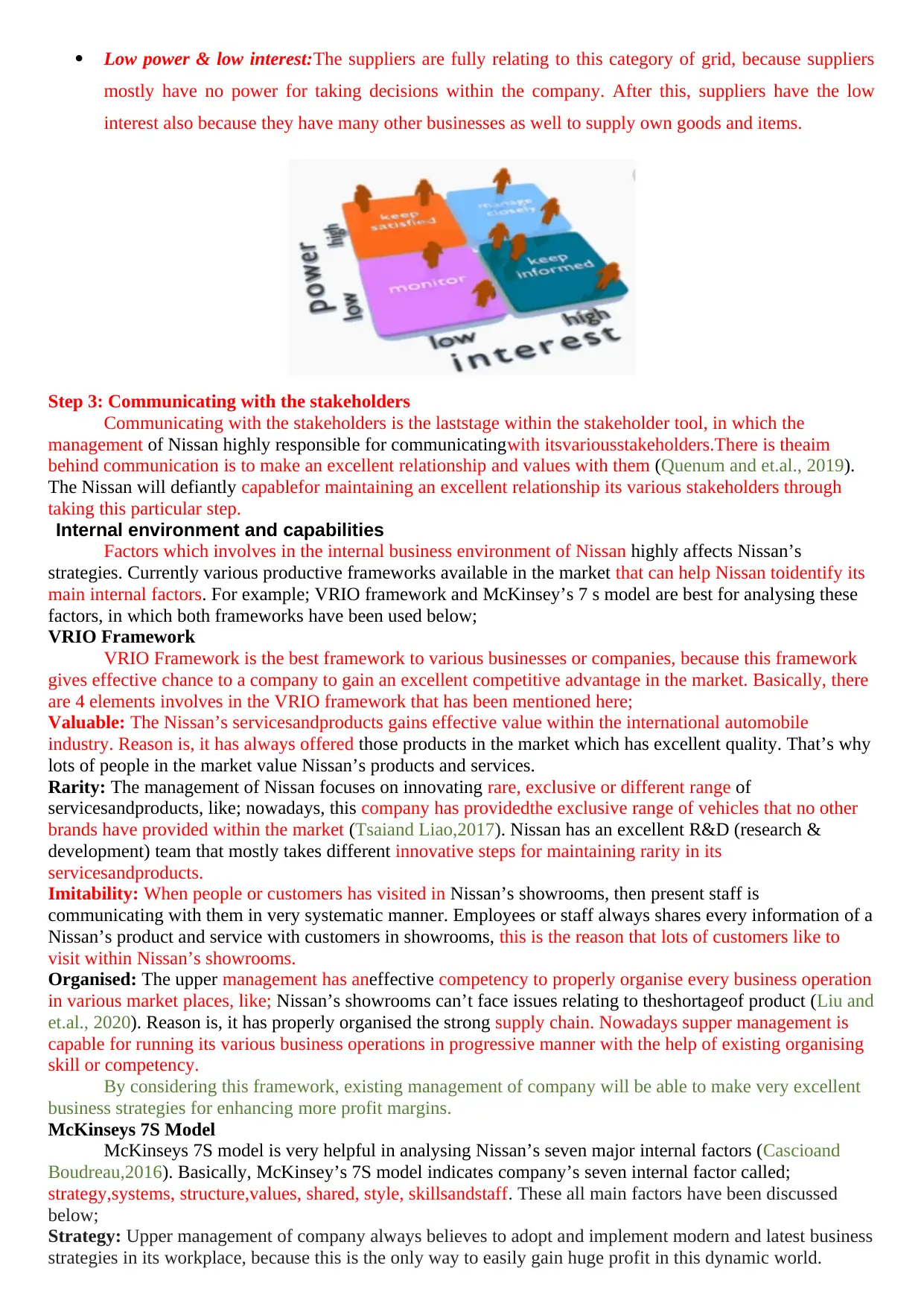
Low power & low interest:The suppliers are fully relating to this category of grid, because suppliers
mostly have no power for taking decisions within the company. After this, suppliers have the low
interest also because they have many other businesses as well to supply own goods and items.
Step 3: Communicating with the stakeholders
Communicating with the stakeholders is the laststage within the stakeholder tool, in which the
management of Nissan highly responsible for communicatingwith itsvariousstakeholders.There is theaim
behind communication is to make an excellent relationship and values with them (Quenum and et.al., 2019).
The Nissan will defiantly capablefor maintaining an excellent relationship its various stakeholders through
taking this particular step.
Internal environment and capabilities
Factors which involves in the internal business environment of Nissan highly affects Nissan’s
strategies. Currently various productive frameworks available in the market that can help Nissan toidentify its
main internal factors. For example; VRIO framework and McKinsey’s 7 s model are best for analysing these
factors, in which both frameworks have been used below;
VRIO Framework
VRIO Framework is the best framework to various businesses or companies, because this framework
gives effective chance to a company to gain an excellent competitive advantage in the market. Basically, there
are 4 elements involves in the VRIO framework that has been mentioned here;
Valuable: The Nissan’s servicesandproducts gains effective value within the international automobile
industry. Reason is, it has always offered those products in the market which has excellent quality. That’s why
lots of people in the market value Nissan’s products and services.
Rarity: The management of Nissan focuses on innovating rare, exclusive or different range of
servicesandproducts, like; nowadays, this company has providedthe exclusive range of vehicles that no other
brands have provided within the market (Tsaiand Liao,2017). Nissan has an excellent R&D (research &
development) team that mostly takes different innovative steps for maintaining rarity in its
servicesandproducts.
Imitability: When people or customers has visited in Nissan’s showrooms, then present staff is
communicating with them in very systematic manner. Employees or staff always shares every information of a
Nissan’s product and service with customers in showrooms, this is the reason that lots of customers like to
visit within Nissan’s showrooms.
Organised: The upper management has aneffective competency to properly organise every business operation
in various market places, like; Nissan’s showrooms can’t face issues relating to theshortageof product (Liu and
et.al., 2020). Reason is, it has properly organised the strong supply chain. Nowadays supper management is
capable for running its various business operations in progressive manner with the help of existing organising
skill or competency.
By considering this framework, existing management of company will be able to make very excellent
business strategies for enhancing more profit margins.
McKinseys 7S Model
McKinseys 7S model is very helpful in analysing Nissan’s seven major internal factors (Cascioand
Boudreau,2016). Basically, McKinsey’s 7S model indicates company’s seven internal factor called;
strategy,systems, structure,values, shared, style, skillsandstaff. These all main factors have been discussed
below;
Strategy: Upper management of company always believes to adopt and implement modern and latest business
strategies in its workplace, because this is the only way to easily gain huge profit in this dynamic world.
mostly have no power for taking decisions within the company. After this, suppliers have the low
interest also because they have many other businesses as well to supply own goods and items.
Step 3: Communicating with the stakeholders
Communicating with the stakeholders is the laststage within the stakeholder tool, in which the
management of Nissan highly responsible for communicatingwith itsvariousstakeholders.There is theaim
behind communication is to make an excellent relationship and values with them (Quenum and et.al., 2019).
The Nissan will defiantly capablefor maintaining an excellent relationship its various stakeholders through
taking this particular step.
Internal environment and capabilities
Factors which involves in the internal business environment of Nissan highly affects Nissan’s
strategies. Currently various productive frameworks available in the market that can help Nissan toidentify its
main internal factors. For example; VRIO framework and McKinsey’s 7 s model are best for analysing these
factors, in which both frameworks have been used below;
VRIO Framework
VRIO Framework is the best framework to various businesses or companies, because this framework
gives effective chance to a company to gain an excellent competitive advantage in the market. Basically, there
are 4 elements involves in the VRIO framework that has been mentioned here;
Valuable: The Nissan’s servicesandproducts gains effective value within the international automobile
industry. Reason is, it has always offered those products in the market which has excellent quality. That’s why
lots of people in the market value Nissan’s products and services.
Rarity: The management of Nissan focuses on innovating rare, exclusive or different range of
servicesandproducts, like; nowadays, this company has providedthe exclusive range of vehicles that no other
brands have provided within the market (Tsaiand Liao,2017). Nissan has an excellent R&D (research &
development) team that mostly takes different innovative steps for maintaining rarity in its
servicesandproducts.
Imitability: When people or customers has visited in Nissan’s showrooms, then present staff is
communicating with them in very systematic manner. Employees or staff always shares every information of a
Nissan’s product and service with customers in showrooms, this is the reason that lots of customers like to
visit within Nissan’s showrooms.
Organised: The upper management has aneffective competency to properly organise every business operation
in various market places, like; Nissan’s showrooms can’t face issues relating to theshortageof product (Liu and
et.al., 2020). Reason is, it has properly organised the strong supply chain. Nowadays supper management is
capable for running its various business operations in progressive manner with the help of existing organising
skill or competency.
By considering this framework, existing management of company will be able to make very excellent
business strategies for enhancing more profit margins.
McKinseys 7S Model
McKinseys 7S model is very helpful in analysing Nissan’s seven major internal factors (Cascioand
Boudreau,2016). Basically, McKinsey’s 7S model indicates company’s seven internal factor called;
strategy,systems, structure,values, shared, style, skillsandstaff. These all main factors have been discussed
below;
Strategy: Upper management of company always believes to adopt and implement modern and latest business
strategies in its workplace, because this is the only way to easily gain huge profit in this dynamic world.
Paraphrase This Document
Need a fresh take? Get an instant paraphrase of this document with our AI Paraphraser
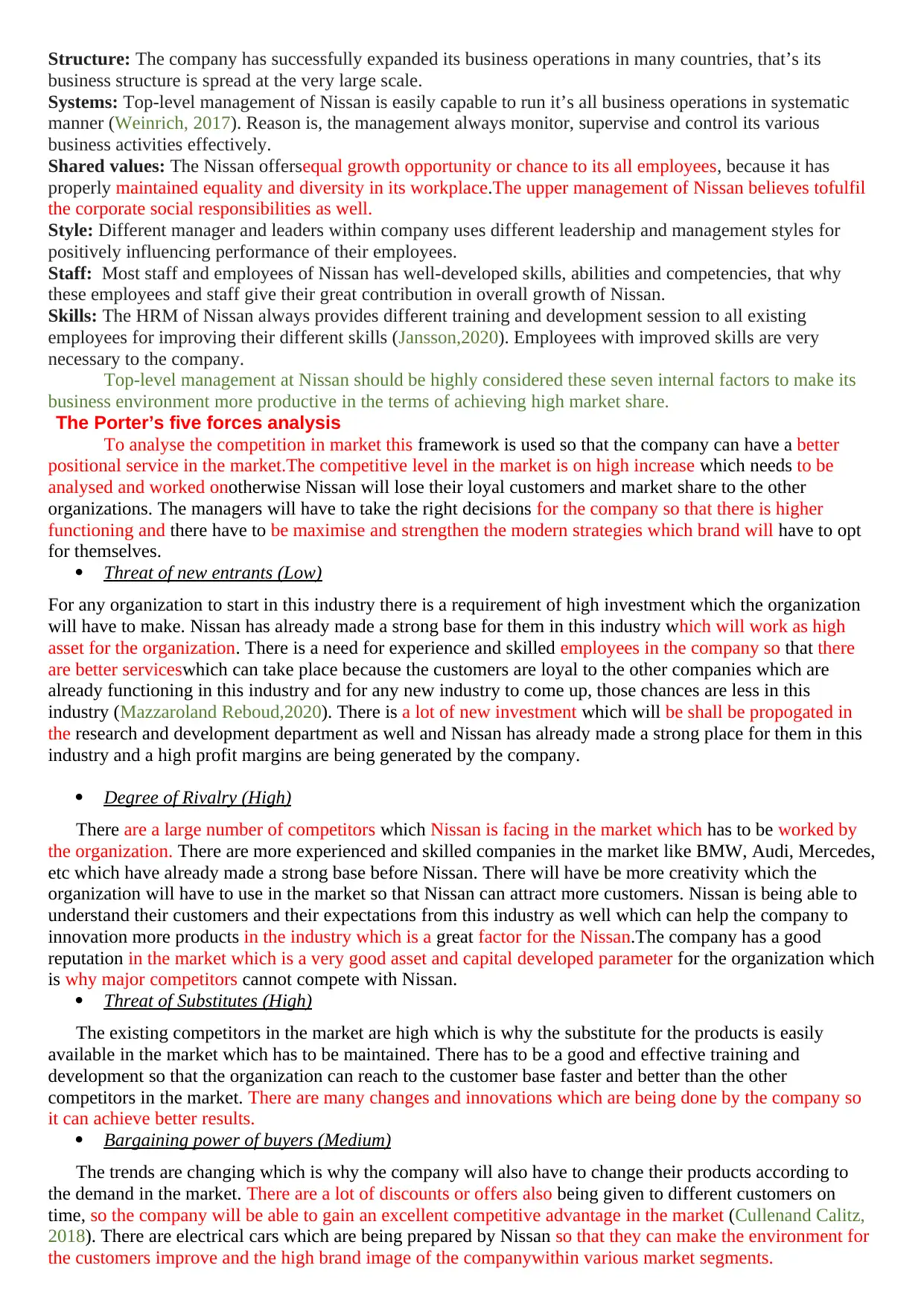
Structure: The company has successfully expanded its business operations in many countries, that’s its
business structure is spread at the very large scale.
Systems: Top-level management of Nissan is easily capable to run it’s all business operations in systematic
manner (Weinrich, 2017). Reason is, the management always monitor, supervise and control its various
business activities effectively.
Shared values: The Nissan offersequal growth opportunity or chance to its all employees, because it has
properly maintained equality and diversity in its workplace.The upper management of Nissan believes tofulfil
the corporate social responsibilities as well.
Style: Different manager and leaders within company uses different leadership and management styles for
positively influencing performance of their employees.
Staff: Most staff and employees of Nissan has well-developed skills, abilities and competencies, that why
these employees and staff give their great contribution in overall growth of Nissan.
Skills: The HRM of Nissan always provides different training and development session to all existing
employees for improving their different skills (Jansson,2020). Employees with improved skills are very
necessary to the company.
Top-level management at Nissan should be highly considered these seven internal factors to make its
business environment more productive in the terms of achieving high market share.
The Porter’s five forces analysis
To analyse the competition in market this framework is used so that the company can have a better
positional service in the market.The competitive level in the market is on high increase which needs to be
analysed and worked onotherwise Nissan will lose their loyal customers and market share to the other
organizations. The managers will have to take the right decisions for the company so that there is higher
functioning and there have to be maximise and strengthen the modern strategies which brand will have to opt
for themselves.
Threat of new entrants (Low)
For any organization to start in this industry there is a requirement of high investment which the organization
will have to make. Nissan has already made a strong base for them in this industry which will work as high
asset for the organization. There is a need for experience and skilled employees in the company so that there
are better serviceswhich can take place because the customers are loyal to the other companies which are
already functioning in this industry and for any new industry to come up, those chances are less in this
industry (Mazzaroland Reboud,2020). There is a lot of new investment which will be shall be propogated in
the research and development department as well and Nissan has already made a strong place for them in this
industry and a high profit margins are being generated by the company.
Degree of Rivalry (High)
There are a large number of competitors which Nissan is facing in the market which has to be worked by
the organization. There are more experienced and skilled companies in the market like BMW, Audi, Mercedes,
etc which have already made a strong base before Nissan. There will have be more creativity which the
organization will have to use in the market so that Nissan can attract more customers. Nissan is being able to
understand their customers and their expectations from this industry as well which can help the company to
innovation more products in the industry which is a great factor for the Nissan.The company has a good
reputation in the market which is a very good asset and capital developed parameter for the organization which
is why major competitors cannot compete with Nissan.
Threat of Substitutes (High)
The existing competitors in the market are high which is why the substitute for the products is easily
available in the market which has to be maintained. There has to be a good and effective training and
development so that the organization can reach to the customer base faster and better than the other
competitors in the market. There are many changes and innovations which are being done by the company so
it can achieve better results.
Bargaining power of buyers (Medium)
The trends are changing which is why the company will also have to change their products according to
the demand in the market. There are a lot of discounts or offers also being given to different customers on
time, so the company will be able to gain an excellent competitive advantage in the market (Cullenand Calitz,
2018). There are electrical cars which are being prepared by Nissan so that they can make the environment for
the customers improve and the high brand image of the companywithin various market segments.
business structure is spread at the very large scale.
Systems: Top-level management of Nissan is easily capable to run it’s all business operations in systematic
manner (Weinrich, 2017). Reason is, the management always monitor, supervise and control its various
business activities effectively.
Shared values: The Nissan offersequal growth opportunity or chance to its all employees, because it has
properly maintained equality and diversity in its workplace.The upper management of Nissan believes tofulfil
the corporate social responsibilities as well.
Style: Different manager and leaders within company uses different leadership and management styles for
positively influencing performance of their employees.
Staff: Most staff and employees of Nissan has well-developed skills, abilities and competencies, that why
these employees and staff give their great contribution in overall growth of Nissan.
Skills: The HRM of Nissan always provides different training and development session to all existing
employees for improving their different skills (Jansson,2020). Employees with improved skills are very
necessary to the company.
Top-level management at Nissan should be highly considered these seven internal factors to make its
business environment more productive in the terms of achieving high market share.
The Porter’s five forces analysis
To analyse the competition in market this framework is used so that the company can have a better
positional service in the market.The competitive level in the market is on high increase which needs to be
analysed and worked onotherwise Nissan will lose their loyal customers and market share to the other
organizations. The managers will have to take the right decisions for the company so that there is higher
functioning and there have to be maximise and strengthen the modern strategies which brand will have to opt
for themselves.
Threat of new entrants (Low)
For any organization to start in this industry there is a requirement of high investment which the organization
will have to make. Nissan has already made a strong base for them in this industry which will work as high
asset for the organization. There is a need for experience and skilled employees in the company so that there
are better serviceswhich can take place because the customers are loyal to the other companies which are
already functioning in this industry and for any new industry to come up, those chances are less in this
industry (Mazzaroland Reboud,2020). There is a lot of new investment which will be shall be propogated in
the research and development department as well and Nissan has already made a strong place for them in this
industry and a high profit margins are being generated by the company.
Degree of Rivalry (High)
There are a large number of competitors which Nissan is facing in the market which has to be worked by
the organization. There are more experienced and skilled companies in the market like BMW, Audi, Mercedes,
etc which have already made a strong base before Nissan. There will have be more creativity which the
organization will have to use in the market so that Nissan can attract more customers. Nissan is being able to
understand their customers and their expectations from this industry as well which can help the company to
innovation more products in the industry which is a great factor for the Nissan.The company has a good
reputation in the market which is a very good asset and capital developed parameter for the organization which
is why major competitors cannot compete with Nissan.
Threat of Substitutes (High)
The existing competitors in the market are high which is why the substitute for the products is easily
available in the market which has to be maintained. There has to be a good and effective training and
development so that the organization can reach to the customer base faster and better than the other
competitors in the market. There are many changes and innovations which are being done by the company so
it can achieve better results.
Bargaining power of buyers (Medium)
The trends are changing which is why the company will also have to change their products according to
the demand in the market. There are a lot of discounts or offers also being given to different customers on
time, so the company will be able to gain an excellent competitive advantage in the market (Cullenand Calitz,
2018). There are electrical cars which are being prepared by Nissan so that they can make the environment for
the customers improve and the high brand image of the companywithin various market segments.
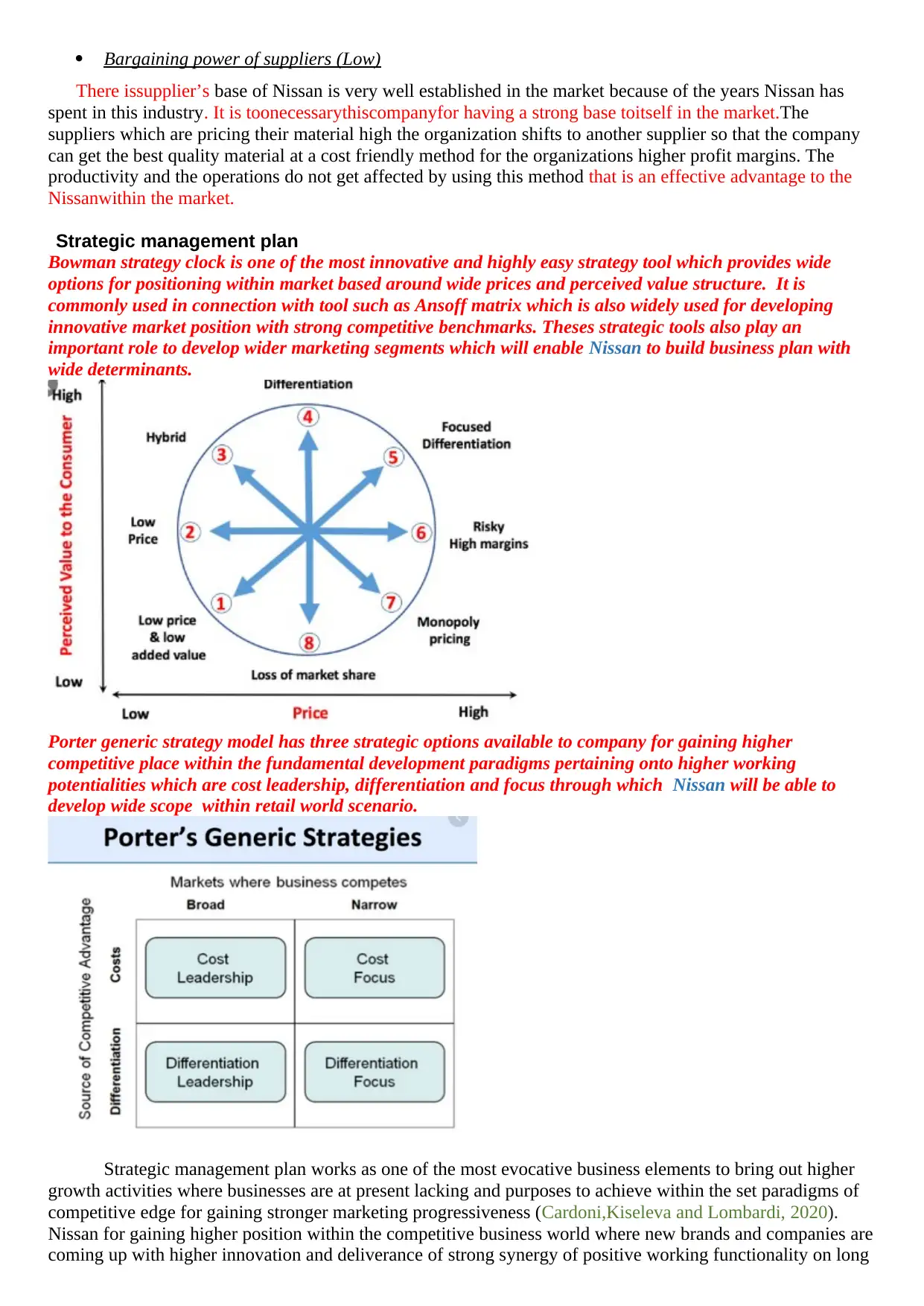
Bargaining power of suppliers (Low)
There issupplier’s base of Nissan is very well established in the market because of the years Nissan has
spent in this industry. It is toonecessarythiscompanyfor having a strong base toitself in the market.The
suppliers which are pricing their material high the organization shifts to another supplier so that the company
can get the best quality material at a cost friendly method for the organizations higher profit margins. The
productivity and the operations do not get affected by using this method that is an effective advantage to the
Nissanwithin the market.
Strategic management plan
Bowman strategy clock is one of the most innovative and highly easy strategy tool which provides wide
options for positioning within market based around wide prices and perceived value structure. It is
commonly used in connection with tool such as Ansoff matrix which is also widely used for developing
innovative market position with strong competitive benchmarks. Theses strategic tools also play an
important role to develop wider marketing segments which will enable Nissan to build business plan with
wide determinants.
Porter generic strategy model has three strategic options available to company for gaining higher
competitive place within the fundamental development paradigms pertaining onto higher working
potentialities which are cost leadership, differentiation and focus through which Nissan will be able to
develop wide scope within retail world scenario.
Strategic management plan works as one of the most evocative business elements to bring out higher
growth activities where businesses are at present lacking and purposes to achieve within the set paradigms of
competitive edge for gaining stronger marketing progressiveness (Cardoni,Kiseleva and Lombardi, 2020).
Nissan for gaining higher position within the competitive business world where new brands and companies are
coming up with higher innovation and deliverance of strong synergy of positive working functionality on long
There issupplier’s base of Nissan is very well established in the market because of the years Nissan has
spent in this industry. It is toonecessarythiscompanyfor having a strong base toitself in the market.The
suppliers which are pricing their material high the organization shifts to another supplier so that the company
can get the best quality material at a cost friendly method for the organizations higher profit margins. The
productivity and the operations do not get affected by using this method that is an effective advantage to the
Nissanwithin the market.
Strategic management plan
Bowman strategy clock is one of the most innovative and highly easy strategy tool which provides wide
options for positioning within market based around wide prices and perceived value structure. It is
commonly used in connection with tool such as Ansoff matrix which is also widely used for developing
innovative market position with strong competitive benchmarks. Theses strategic tools also play an
important role to develop wider marketing segments which will enable Nissan to build business plan with
wide determinants.
Porter generic strategy model has three strategic options available to company for gaining higher
competitive place within the fundamental development paradigms pertaining onto higher working
potentialities which are cost leadership, differentiation and focus through which Nissan will be able to
develop wide scope within retail world scenario.
Strategic management plan works as one of the most evocative business elements to bring out higher
growth activities where businesses are at present lacking and purposes to achieve within the set paradigms of
competitive edge for gaining stronger marketing progressiveness (Cardoni,Kiseleva and Lombardi, 2020).
Nissan for gaining higher position within the competitive business world where new brands and companies are
coming up with higher innovation and deliverance of strong synergy of positive working functionality on long
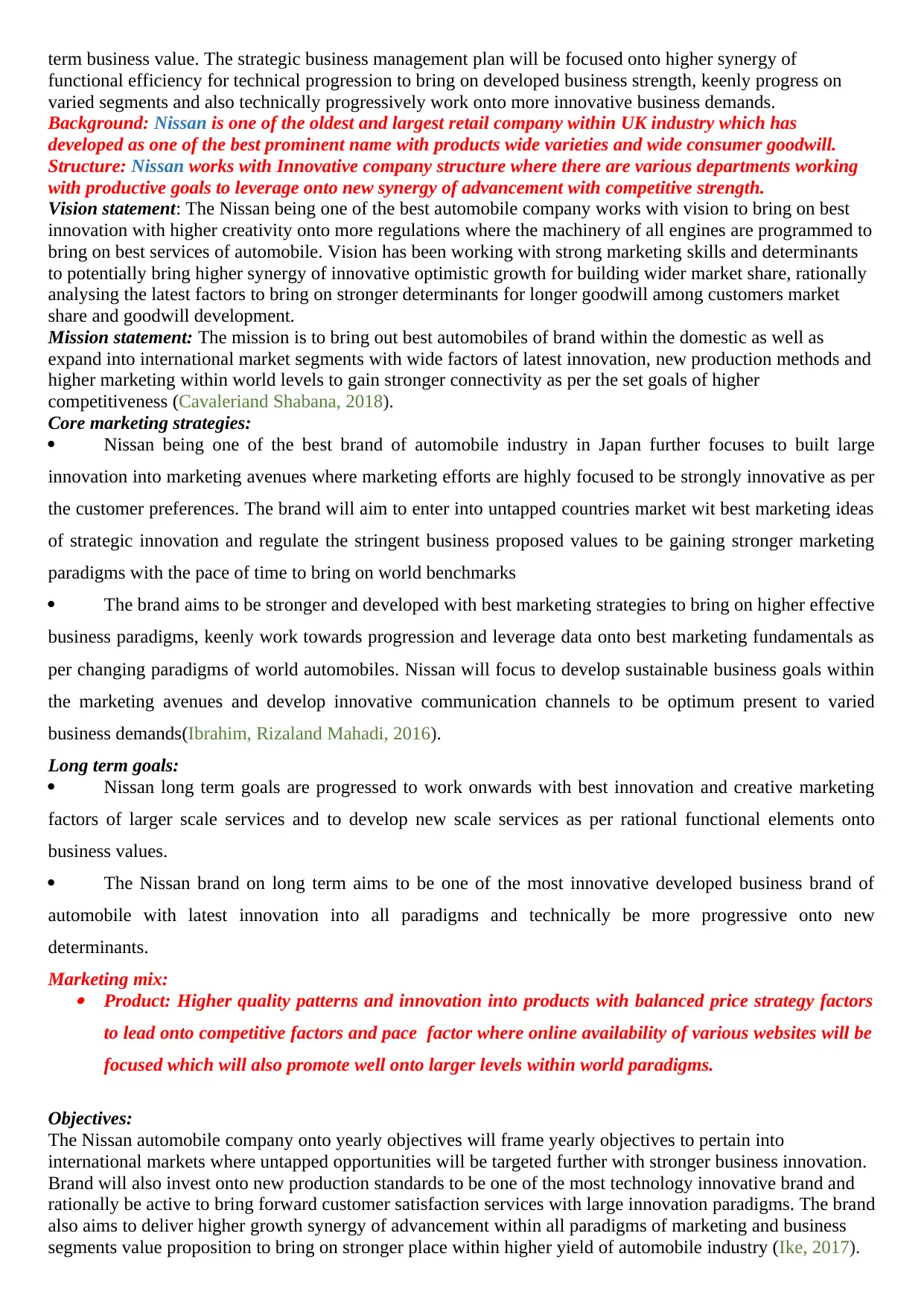
term business value. The strategic business management plan will be focused onto higher synergy of
functional efficiency for technical progression to bring on developed business strength, keenly progress on
varied segments and also technically progressively work onto more innovative business demands.
Background: Nissan is one of the oldest and largest retail company within UK industry which has
developed as one of the best prominent name with products wide varieties and wide consumer goodwill.
Structure: Nissan works with Innovative company structure where there are various departments working
with productive goals to leverage onto new synergy of advancement with competitive strength.
Vision statement: The Nissan being one of the best automobile company works with vision to bring on best
innovation with higher creativity onto more regulations where the machinery of all engines are programmed to
bring on best services of automobile. Vision has been working with strong marketing skills and determinants
to potentially bring higher synergy of innovative optimistic growth for building wider market share, rationally
analysing the latest factors to bring on stronger determinants for longer goodwill among customers market
share and goodwill development.
Mission statement: The mission is to bring out best automobiles of brand within the domestic as well as
expand into international market segments with wide factors of latest innovation, new production methods and
higher marketing within world levels to gain stronger connectivity as per the set goals of higher
competitiveness (Cavaleriand Shabana, 2018).
Core marketing strategies:
Nissan being one of the best brand of automobile industry in Japan further focuses to built large
innovation into marketing avenues where marketing efforts are highly focused to be strongly innovative as per
the customer preferences. The brand will aim to enter into untapped countries market wit best marketing ideas
of strategic innovation and regulate the stringent business proposed values to be gaining stronger marketing
paradigms with the pace of time to bring on world benchmarks
The brand aims to be stronger and developed with best marketing strategies to bring on higher effective
business paradigms, keenly work towards progression and leverage data onto best marketing fundamentals as
per changing paradigms of world automobiles. Nissan will focus to develop sustainable business goals within
the marketing avenues and develop innovative communication channels to be optimum present to varied
business demands(Ibrahim, Rizaland Mahadi, 2016).
Long term goals:
Nissan long term goals are progressed to work onwards with best innovation and creative marketing
factors of larger scale services and to develop new scale services as per rational functional elements onto
business values.
The Nissan brand on long term aims to be one of the most innovative developed business brand of
automobile with latest innovation into all paradigms and technically be more progressive onto new
determinants.
Marketing mix: Product: Higher quality patterns and innovation into products with balanced price strategy factors
to lead onto competitive factors and pace factor where online availability of various websites will be
focused which will also promote well onto larger levels within world paradigms.
Objectives:
The Nissan automobile company onto yearly objectives will frame yearly objectives to pertain into
international markets where untapped opportunities will be targeted further with stronger business innovation.
Brand will also invest onto new production standards to be one of the most technology innovative brand and
rationally be active to bring forward customer satisfaction services with large innovation paradigms. The brand
also aims to deliver higher growth synergy of advancement within all paradigms of marketing and business
segments value proposition to bring on stronger place within higher yield of automobile industry (Ike, 2017).
functional efficiency for technical progression to bring on developed business strength, keenly progress on
varied segments and also technically progressively work onto more innovative business demands.
Background: Nissan is one of the oldest and largest retail company within UK industry which has
developed as one of the best prominent name with products wide varieties and wide consumer goodwill.
Structure: Nissan works with Innovative company structure where there are various departments working
with productive goals to leverage onto new synergy of advancement with competitive strength.
Vision statement: The Nissan being one of the best automobile company works with vision to bring on best
innovation with higher creativity onto more regulations where the machinery of all engines are programmed to
bring on best services of automobile. Vision has been working with strong marketing skills and determinants
to potentially bring higher synergy of innovative optimistic growth for building wider market share, rationally
analysing the latest factors to bring on stronger determinants for longer goodwill among customers market
share and goodwill development.
Mission statement: The mission is to bring out best automobiles of brand within the domestic as well as
expand into international market segments with wide factors of latest innovation, new production methods and
higher marketing within world levels to gain stronger connectivity as per the set goals of higher
competitiveness (Cavaleriand Shabana, 2018).
Core marketing strategies:
Nissan being one of the best brand of automobile industry in Japan further focuses to built large
innovation into marketing avenues where marketing efforts are highly focused to be strongly innovative as per
the customer preferences. The brand will aim to enter into untapped countries market wit best marketing ideas
of strategic innovation and regulate the stringent business proposed values to be gaining stronger marketing
paradigms with the pace of time to bring on world benchmarks
The brand aims to be stronger and developed with best marketing strategies to bring on higher effective
business paradigms, keenly work towards progression and leverage data onto best marketing fundamentals as
per changing paradigms of world automobiles. Nissan will focus to develop sustainable business goals within
the marketing avenues and develop innovative communication channels to be optimum present to varied
business demands(Ibrahim, Rizaland Mahadi, 2016).
Long term goals:
Nissan long term goals are progressed to work onwards with best innovation and creative marketing
factors of larger scale services and to develop new scale services as per rational functional elements onto
business values.
The Nissan brand on long term aims to be one of the most innovative developed business brand of
automobile with latest innovation into all paradigms and technically be more progressive onto new
determinants.
Marketing mix: Product: Higher quality patterns and innovation into products with balanced price strategy factors
to lead onto competitive factors and pace factor where online availability of various websites will be
focused which will also promote well onto larger levels within world paradigms.
Objectives:
The Nissan automobile company onto yearly objectives will frame yearly objectives to pertain into
international markets where untapped opportunities will be targeted further with stronger business innovation.
Brand will also invest onto new production standards to be one of the most technology innovative brand and
rationally be active to bring forward customer satisfaction services with large innovation paradigms. The brand
also aims to deliver higher growth synergy of advancement within all paradigms of marketing and business
segments value proposition to bring on stronger place within higher yield of automobile industry (Ike, 2017).
Secure Best Marks with AI Grader
Need help grading? Try our AI Grader for instant feedback on your assignments.
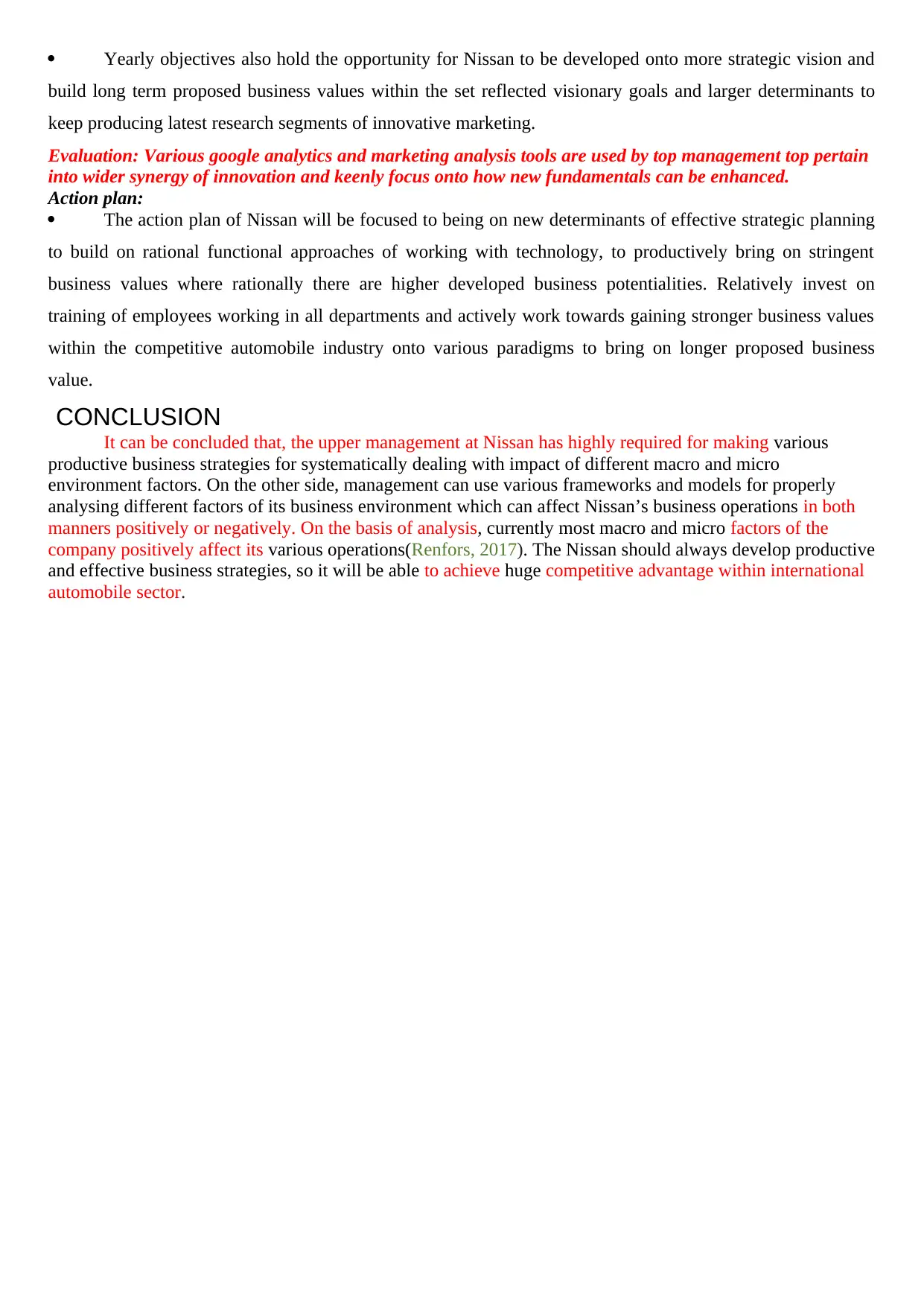
Yearly objectives also hold the opportunity for Nissan to be developed onto more strategic vision and
build long term proposed business values within the set reflected visionary goals and larger determinants to
keep producing latest research segments of innovative marketing.
Evaluation: Various google analytics and marketing analysis tools are used by top management top pertain
into wider synergy of innovation and keenly focus onto how new fundamentals can be enhanced.
Action plan:
The action plan of Nissan will be focused to being on new determinants of effective strategic planning
to build on rational functional approaches of working with technology, to productively bring on stringent
business values where rationally there are higher developed business potentialities. Relatively invest on
training of employees working in all departments and actively work towards gaining stronger business values
within the competitive automobile industry onto various paradigms to bring on longer proposed business
value.
CONCLUSION
It can be concluded that, the upper management at Nissan has highly required for making various
productive business strategies for systematically dealing with impact of different macro and micro
environment factors. On the other side, management can use various frameworks and models for properly
analysing different factors of its business environment which can affect Nissan’s business operations in both
manners positively or negatively. On the basis of analysis, currently most macro and micro factors of the
company positively affect its various operations(Renfors, 2017). The Nissan should always develop productive
and effective business strategies, so it will be able to achieve huge competitive advantage within international
automobile sector.
build long term proposed business values within the set reflected visionary goals and larger determinants to
keep producing latest research segments of innovative marketing.
Evaluation: Various google analytics and marketing analysis tools are used by top management top pertain
into wider synergy of innovation and keenly focus onto how new fundamentals can be enhanced.
Action plan:
The action plan of Nissan will be focused to being on new determinants of effective strategic planning
to build on rational functional approaches of working with technology, to productively bring on stringent
business values where rationally there are higher developed business potentialities. Relatively invest on
training of employees working in all departments and actively work towards gaining stronger business values
within the competitive automobile industry onto various paradigms to bring on longer proposed business
value.
CONCLUSION
It can be concluded that, the upper management at Nissan has highly required for making various
productive business strategies for systematically dealing with impact of different macro and micro
environment factors. On the other side, management can use various frameworks and models for properly
analysing different factors of its business environment which can affect Nissan’s business operations in both
manners positively or negatively. On the basis of analysis, currently most macro and micro factors of the
company positively affect its various operations(Renfors, 2017). The Nissan should always develop productive
and effective business strategies, so it will be able to achieve huge competitive advantage within international
automobile sector.
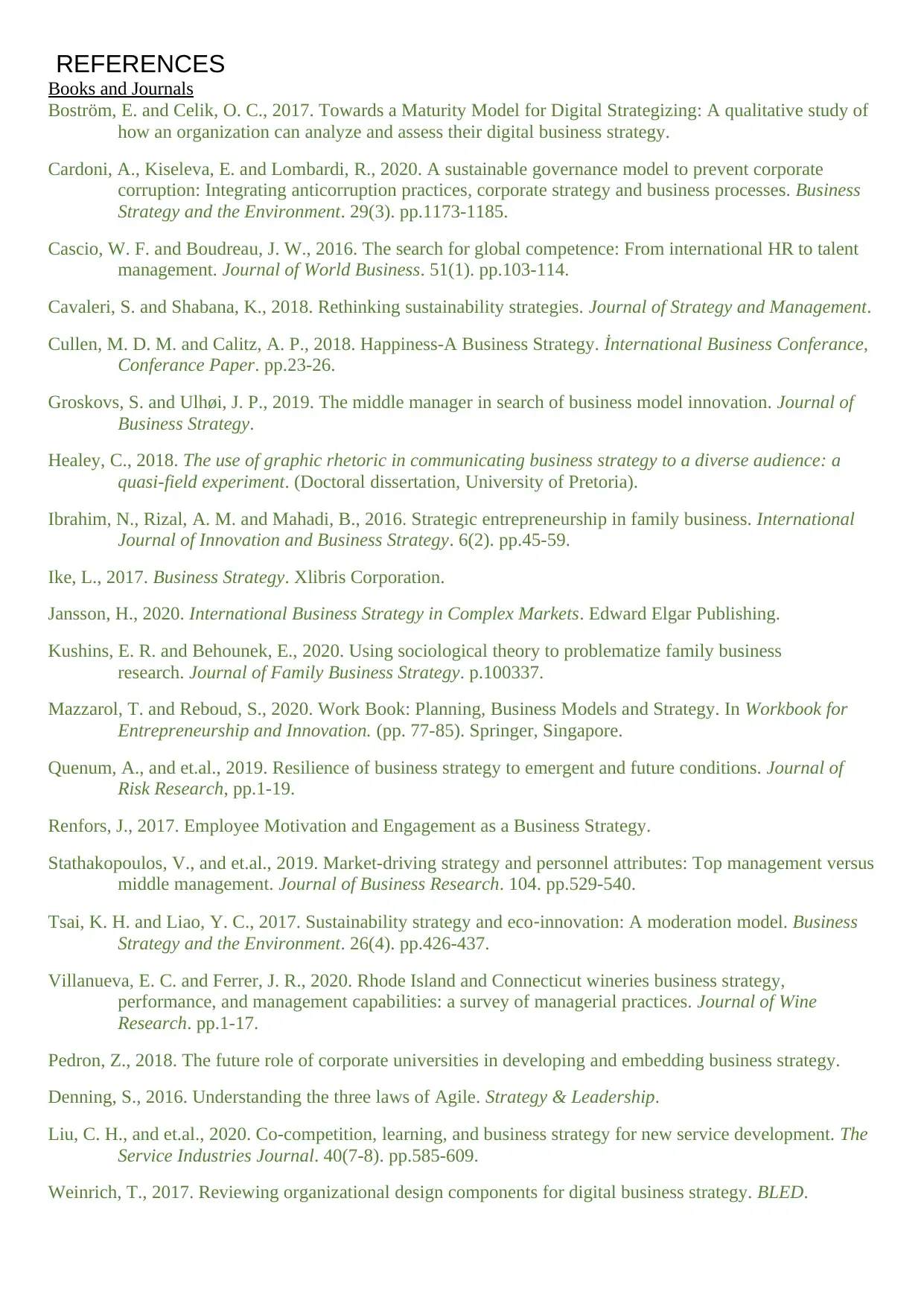
REFERENCES
Books and Journals
Boström, E. and Celik, O. C., 2017. Towards a Maturity Model for Digital Strategizing: A qualitative study of
how an organization can analyze and assess their digital business strategy.
Cardoni, A., Kiseleva, E. and Lombardi, R., 2020. A sustainable governance model to prevent corporate
corruption: Integrating anticorruption practices, corporate strategy and business processes. Business
Strategy and the Environment. 29(3). pp.1173-1185.
Cascio, W. F. and Boudreau, J. W., 2016. The search for global competence: From international HR to talent
management. Journal of World Business. 51(1). pp.103-114.
Cavaleri, S. and Shabana, K., 2018. Rethinking sustainability strategies. Journal of Strategy and Management.
Cullen, M. D. M. and Calitz, A. P., 2018. Happiness-A Business Strategy. İnternational Business Conferance,
Conferance Paper. pp.23-26.
Groskovs, S. and Ulhøi, J. P., 2019. The middle manager in search of business model innovation. Journal of
Business Strategy.
Healey, C., 2018. The use of graphic rhetoric in communicating business strategy to a diverse audience: a
quasi-field experiment. (Doctoral dissertation, University of Pretoria).
Ibrahim, N., Rizal, A. M. and Mahadi, B., 2016. Strategic entrepreneurship in family business. International
Journal of Innovation and Business Strategy. 6(2). pp.45-59.
Ike, L., 2017. Business Strategy. Xlibris Corporation.
Jansson, H., 2020. International Business Strategy in Complex Markets. Edward Elgar Publishing.
Kushins, E. R. and Behounek, E., 2020. Using sociological theory to problematize family business
research. Journal of Family Business Strategy. p.100337.
Mazzarol, T. and Reboud, S., 2020. Work Book: Planning, Business Models and Strategy. In Workbook for
Entrepreneurship and Innovation. (pp. 77-85). Springer, Singapore.
Quenum, A., and et.al., 2019. Resilience of business strategy to emergent and future conditions. Journal of
Risk Research, pp.1-19.
Renfors, J., 2017. Employee Motivation and Engagement as a Business Strategy.
Stathakopoulos, V., and et.al., 2019. Market-driving strategy and personnel attributes: Top management versus
middle management. Journal of Business Research. 104. pp.529-540.
Tsai, K. H. and Liao, Y. C., 2017. Sustainability strategy and eco‐innovation: A moderation model. Business
Strategy and the Environment. 26(4). pp.426-437.
Villanueva, E. C. and Ferrer, J. R., 2020. Rhode Island and Connecticut wineries business strategy,
performance, and management capabilities: a survey of managerial practices. Journal of Wine
Research. pp.1-17.
Pedron, Z., 2018. The future role of corporate universities in developing and embedding business strategy.
Denning, S., 2016. Understanding the three laws of Agile. Strategy & Leadership.
Liu, C. H., and et.al., 2020. Co-competition, learning, and business strategy for new service development. The
Service Industries Journal. 40(7-8). pp.585-609.
Weinrich, T., 2017. Reviewing organizational design components for digital business strategy. BLED.
Books and Journals
Boström, E. and Celik, O. C., 2017. Towards a Maturity Model for Digital Strategizing: A qualitative study of
how an organization can analyze and assess their digital business strategy.
Cardoni, A., Kiseleva, E. and Lombardi, R., 2020. A sustainable governance model to prevent corporate
corruption: Integrating anticorruption practices, corporate strategy and business processes. Business
Strategy and the Environment. 29(3). pp.1173-1185.
Cascio, W. F. and Boudreau, J. W., 2016. The search for global competence: From international HR to talent
management. Journal of World Business. 51(1). pp.103-114.
Cavaleri, S. and Shabana, K., 2018. Rethinking sustainability strategies. Journal of Strategy and Management.
Cullen, M. D. M. and Calitz, A. P., 2018. Happiness-A Business Strategy. İnternational Business Conferance,
Conferance Paper. pp.23-26.
Groskovs, S. and Ulhøi, J. P., 2019. The middle manager in search of business model innovation. Journal of
Business Strategy.
Healey, C., 2018. The use of graphic rhetoric in communicating business strategy to a diverse audience: a
quasi-field experiment. (Doctoral dissertation, University of Pretoria).
Ibrahim, N., Rizal, A. M. and Mahadi, B., 2016. Strategic entrepreneurship in family business. International
Journal of Innovation and Business Strategy. 6(2). pp.45-59.
Ike, L., 2017. Business Strategy. Xlibris Corporation.
Jansson, H., 2020. International Business Strategy in Complex Markets. Edward Elgar Publishing.
Kushins, E. R. and Behounek, E., 2020. Using sociological theory to problematize family business
research. Journal of Family Business Strategy. p.100337.
Mazzarol, T. and Reboud, S., 2020. Work Book: Planning, Business Models and Strategy. In Workbook for
Entrepreneurship and Innovation. (pp. 77-85). Springer, Singapore.
Quenum, A., and et.al., 2019. Resilience of business strategy to emergent and future conditions. Journal of
Risk Research, pp.1-19.
Renfors, J., 2017. Employee Motivation and Engagement as a Business Strategy.
Stathakopoulos, V., and et.al., 2019. Market-driving strategy and personnel attributes: Top management versus
middle management. Journal of Business Research. 104. pp.529-540.
Tsai, K. H. and Liao, Y. C., 2017. Sustainability strategy and eco‐innovation: A moderation model. Business
Strategy and the Environment. 26(4). pp.426-437.
Villanueva, E. C. and Ferrer, J. R., 2020. Rhode Island and Connecticut wineries business strategy,
performance, and management capabilities: a survey of managerial practices. Journal of Wine
Research. pp.1-17.
Pedron, Z., 2018. The future role of corporate universities in developing and embedding business strategy.
Denning, S., 2016. Understanding the three laws of Agile. Strategy & Leadership.
Liu, C. H., and et.al., 2020. Co-competition, learning, and business strategy for new service development. The
Service Industries Journal. 40(7-8). pp.585-609.
Weinrich, T., 2017. Reviewing organizational design components for digital business strategy. BLED.
1 out of 12
Your All-in-One AI-Powered Toolkit for Academic Success.
+13062052269
info@desklib.com
Available 24*7 on WhatsApp / Email
![[object Object]](/_next/static/media/star-bottom.7253800d.svg)
Unlock your academic potential
© 2024 | Zucol Services PVT LTD | All rights reserved.





